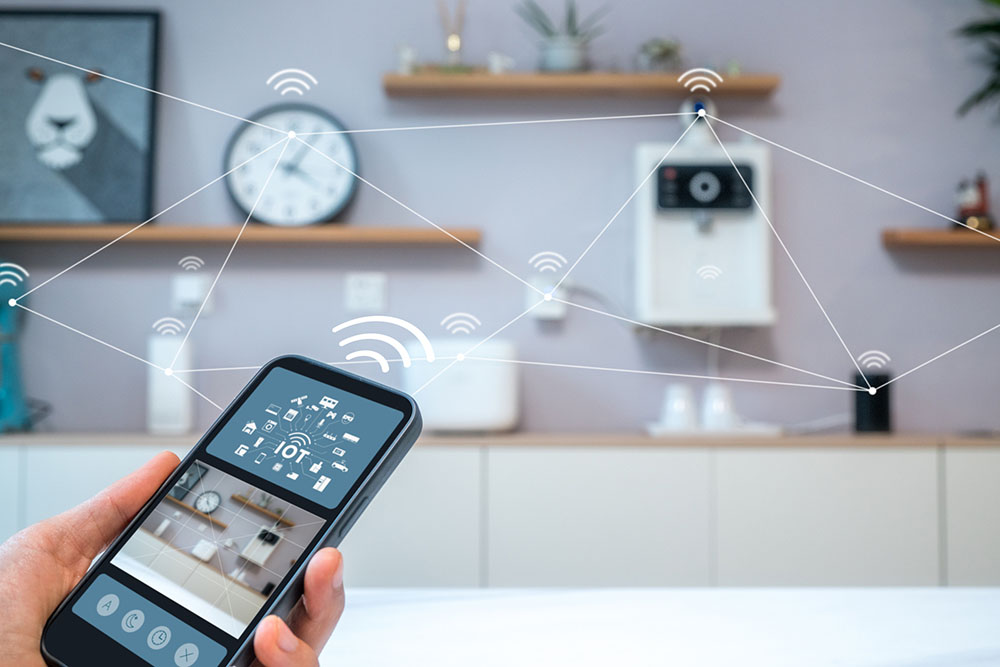In 2014, the percentage of companies using the internet of things (IoT) stood at 13%. By 2019 it reached 25%. Today, the IoT is used by 29% of EU enterprises (48% for large businesses) and the spread of this exciting technology is only increasing. Yet what is the internet of things and what opportunities may lie ahead for investors? Below, our team at Bure Valley Group explains the journey of the internet of things in recent years, the current landscape (e.g. key players and rising stars), trends, opportunities and risks to consider. We hope you find this industry report helpful as you consider your own portfolio.
The journey of the internet of things (IoT)
The internet of things (IoT), broadly speaking, is a huge worldwide network of interconnected people and objects. These share data with each other about their usage and interactions with the world around them. The IoT, therefore, encompasses a huge range of ideas and innovations from self-driving cars to smart microwaves (automatically cooking food), wrist-borne fitness devices and home-bound robots which clean the floors at specified times.
These ideas can be traced back as far as the 1980s, when Coca-Cola vending machines started reporting their inventory about their loaded and cold drinks. By the 1990s, academic venues such as UbiComp and PerCom were publishing about the modern vision for the IoT, with solutions like Microsoft’s at Work or Novell’s NEST appearing. The “true” IoT is believed to have been born in 2008 and 2009, when the number of connected devices first overtook the number of connected people.
The IoT landscape in 2022
In 2021, the global IoT market was estimated at $384.70bn. Currently, in 2022, it stands at $478.36bn and is projected to grow to £2,465.26bn by 2026 (a Compound Annual Growth Rate of 26.4%). This is despite a huge fall in global demand by 23.4% in 2020 (from the previous year) due to the COVID-19 pandemic.
Key players in the IoT space include AT&T which has been leading the way in helping to develop “smart cities” for pedestrian sensors, smart parking metres and public WiFi. Cisco has also been a key player in driving IoT innovations within industrial networks (e.g. industrial switching, routers and gateways). Siemens AG is another large company in the space, even using cloud data to help motorbike racing drivers improve their driving strategy and style.
The impact of COVID-19
Whilst the pandemic may seem like “old news” now, it is still having an impact on the IoT landscape today and future trends. In particular, COVID-19 forced governments to prioritise citizen health and look for solutions to help prevent needless spread of the virus. In the UK, “track and trace” used IoT technology so individuals would identify close contacts who were recently diagnosed with COVID-19, and avoid them. Indeed, the pandemic arguably brought in an unprecedented level of government move into citizens’ personal technology (through apps on their smartphones), setting a precedent for similar moves in the future if deemed necessary – particularly since the world still faces no shortage of threats from other pandemics.
Future trends
With the world becoming increasingly urbanised, IoT technology is likely to become even more essential as more smart cities are developed to promote safety, efficiency and sustainability. Saudi Arabia is an interesting example with its development of NEOM, Qiddiya, the Red Sea Project and Amaala (its four new smart cities). Increasing global populations and rising middle classes – particularly in many Asian countries (e.g. China and Vietnam) – is also likely to drive further demand for IoT technologies from ordinary customers.
There are restraining factors to the IoT, however. Since many innovations involve the gathering of personal data (e.g. fitness watches), there are privacy and data protection concerns which need addressing. Western governments, in particular, might be more inclined to place regulatory barriers in front of IoT innovations that are deemed “too intrusive”. There is also the risk of data security. As more devices become interconnected, more “entry points” emerge for hackers to potentially intercept and steal sensitive information (e.g. company financial information or government secrets). Cybersecurity, therefore, is likely to become increasingly in demand as the IoT continues its current trajectory deeper into market segments.
Interesting IoT startups to watch
Many large-cap companies are naturally well-positioned to offer IoT innovations to the world due to their dominance in the hardware space. Yet there are many compelling startups offering IoT niche innovations that will be attractive to early-stage investors. EVRYTHNG is a case in point. Founded by two UK individuals and now a multi-million-pound firm, the company currently operates in three countries and has set up an IoT smart products Platform-as-a-Service. This allows customers to connect products from cars to clothes, beer bottles or homes.
Another rising IoT player is KisanHub; a Cambridge-based company offering satellite technology and in-field sensors to farmers. The sensors provide farmers with information such as wind speed, crop growth and rainfall – allowing them to make more efficient decisions. Everything can be seen clearly on a digestible dashboard, giving farmers greater visibility when managing stock and equipment across multiple sites.
Conclusion
If you are interested in expanding your portfolio into these kinds of exciting spheres of investing, then we invite you to get in touch with us here at Bure Valley and to consider joining our exclusive investor network:
+44 160 334 0827


